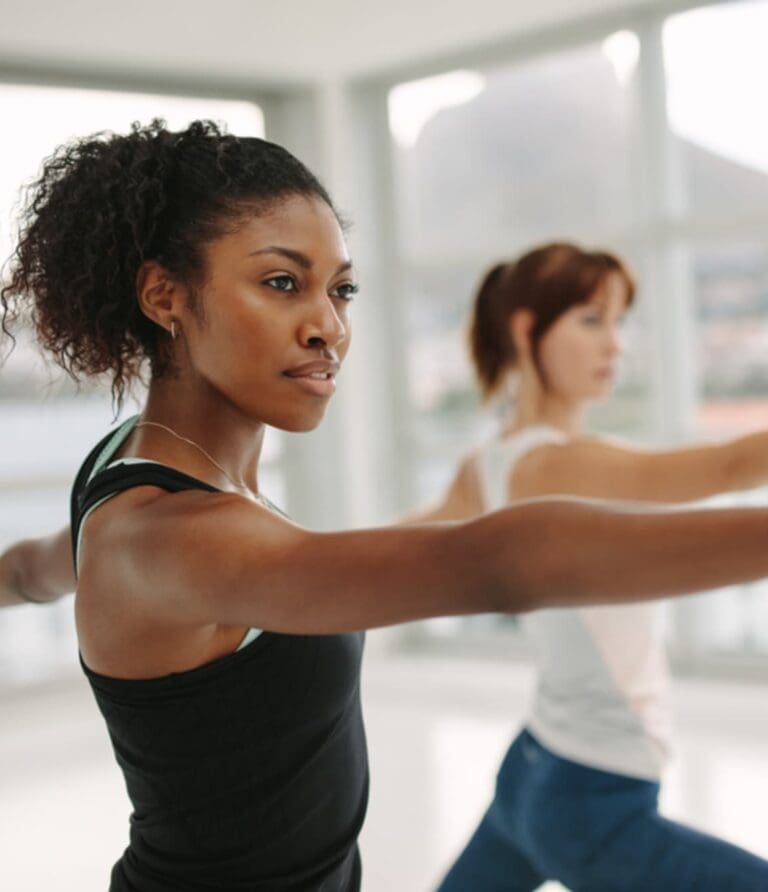Introduction: Taking the First Step Towards Fitness Success
Have you ever stood at the gym entrance, heart racing, palm sweaty, feeling like you’re about to step onto a stage rather than a treadmill? If so, you’re not alone. Gym anxiety is a real phenomenon that affects countless individuals, from fitness newbies to seasoned athletes. Here at Holly Roser Fitness in San Mateo, we understand that the journey to better health isn’t just about physical strength—it’s about mental fortitude too.
As a personal trainer with years of experience, I’ve seen firsthand how intimidating the gym environment can be. The clanking of weights, the whirl of machines, and the sight of seemingly perfect bodies can be overwhelming. But here’s the thing: everyone starts somewhere, and everyone has the right to feel comfortable pursuing their fitness goals.
In this comprehensive guide, we’ll dive deep into the world of gym anxiety, exploring its roots, its impact, and most importantly, how to overcome it. We’ll look at evidence-based strategies, share real-life success stories, and provide you with actionable steps to transform your gym experience from dreadful to delightful.
So, whether you’re a San Mateo local looking to kickstart your fitness journey or someone from afar seeking guidance, buckle up. We’re about to embark on a transformative adventure that’ll not only help you conquer gym anxiety but also unlock your true potential. Ready to break a sweat without breaking into a panic? Let’s dive in!
Understanding Gym Anxiety: You’re Not Alone
Before we jump into solutions, let’s take a moment to understand what we’re dealing with. Gym anxiety isn’t just a case of nerves—it’s a complex psychological phenomenon that can manifest in various ways.
Research conducted by Pridgeon and Grogan (2012) showed that gym anxiety often stems from:
- Fear of judgment
- Lack of confidence in one’s abilities
- Feeling out of place in the fitness environment
It’s that nagging voice in your head saying, “Everyone’s staring at me,” or “I don’t know how to use this equipment.”
The good news? Recognizing these feelings is the first step towards overcoming them. And trust me, you’re in good company. A survey by Fitrated found that:
- 65% of women avoid the gym due to fear of being judged
- 36% of men feel too intimidated to attend exercise classes
But here’s the kicker: most gym-goers are too focused on their own workouts to pay attention to others. That buff guy lifting heavy weights? He’s probably worrying about his form. The woman running on the treadmill? She’s likely concentrating on her breathing, not on you.
The Science Behind Gym Anxiety: What’s Really Going On?
Now that we’ve established the prevalence of gym anxiety, let’s dive into the nitty-gritty. What’s actually happening in your body when anxiety strikes?
The Physiological Response: Fight, Flight, or Freeze
When you experience anxiety, your body goes into what’s known as the “fight, flight, or freeze” response. This mechanism, designed to protect us from danger, can kick in at inopportune moments—like when you’re trying to start a workout.
A study by Spielberger and Reheiser (2009) found that anxiety triggers a cascade of hormones, including adrenaline and cortisol. These hormones cause physical symptoms like:
- Increased heart rate
- Sweating
- Shortness of breath
Sound familiar? It’s your body preparing for perceived danger, even though the only real threat is to your comfort zone.
The Psychological Impact: Self-Doubt and Negative Self-Talk
Gym anxiety isn’t just physical—it’s a mental game too. Negative self-talk can be a major culprit. “I’m too out of shape to be here,” or “I’ll look silly trying to use that piece of equipment,” are common thoughts that can derail your fitness intentions before you even start.
Research by Hausenblas et al. (2004) showed that individuals with high levels of social physique anxiety—concern about how others perceive their bodies—were less likely to adhere to exercise programs. This creates a vicious cycle: anxiety leads to avoidance, which in turn reinforces the anxiety.
But don’t worry—we’re about to break that cycle.
Strategies to Overcome Gym Anxiety: Your Roadmap to Confidence
Alright, now that we’ve got the background sorted, let’s roll up our sleeves and get to the good stuff. Here are evidence-based strategies to help you kick gym anxiety to the curb.
Start Small: The Power of Incremental Steps
Remember the old saying, “How do you eat an elephant? One bite at a time.” The same principle applies to conquering gym anxiety. Instead of diving headfirst into a packed gym during peak hours, start small.
At Holly Roser Fitness, we offer private, personalized sessions that can help you acclimate to the gym environment at your own pace. You can book a consultation with us to discuss a plan tailored to your comfort level. You can start in a private gym setting. Just you and your trainer and go from there.
A study by Annesi (2004) found that gradual exposure to gym environments, combined with cognitive-behavioral strategies, significantly reduced exercise anxiety in participants. So, take it slow—Rome wasn’t built in a day, and neither is gym confidence.
Knowledge is Power: Familiarize Yourself with Equipment and Routines
One of the biggest sources of gym anxiety is the fear of looking silly or not knowing how to use equipment. The solution? Arm yourself with knowledge.
Consider booking a session with a personal trainer who can show you the ropes. At Holly Roser Fitness, we offer individualized training with the help of certified personal trainers to help you feel more comfortable. You’d be surprised how much a little know-how can boost your confidence.
Research by Lox et al. (2010) showed that increased exercise knowledge and self-efficacy were associated with reduced anxiety and greater exercise adherence. So go ahead, ask questions, watch tutorial videos, and don’t be afraid to start with simpler exercises. Remember, every expert was once a beginner.
Find Your Tribe: The Benefits of Group Classes or a Workout Buddy
There’s strength in numbers, and when it comes to overcoming gym anxiety, this couldn’t be truer. Joining a group class or finding a workout buddy can provide moral support and accountability.
A study by Plante et al. (2001) found that exercising with others not only reduced anxiety but also increased enjoyment of the workout. At Holly Roser Fitness, we also offer group sessions that foster a supportive community atmosphere. You might just find that the gym becomes less of a scary place and more of a social outing!
Mindfulness and Meditation: Calming the Mental Storm
When anxiety strikes, it can feel like your thoughts are running a marathon. That’s where mindfulness and meditation come in. These practices can help you stay present and focused, rather than getting caught up in anxious thoughts.
Research by Stonerock et al. (2015) showed that mindfulness-based interventions could significantly reduce anxiety symptoms in various populations, including those with exercise-related anxiety.
Try this simple technique next time you’re feeling anxious at the gym:
- Take a deep breath in for 4 counts.
- Hold for 4 counts.
- Exhale for 4 counts.
- Repeat 3-5 times.
This quick exercise can help ground you and bring your focus back to the present moment.
Preparing for Success: Pre-Gym Rituals and Routines
Now that we’ve covered some major strategies, let’s talk about setting yourself up for success before you even step foot in the gym.
Dress for Success: The Psychology of Gym Attire
Ever heard the phrase “dress for the job you want”? Well, the same principle applies to fitness. Wearing comfortable, well-fitting gym clothes can boost your confidence and help you feel more at home in the gym environment.
A study by Hajo and Galinsky (2012) found that clothing can influence behavior and attitudes. Participants who wore lab coats described as doctors’ coats showed increased attention and focus compared to those who didn’t. While this study wasn’t specifically about gym clothes, it demonstrates the powerful psychological effect clothing can have.
So, invest in gym wear that makes you feel good. It doesn’t have to be the latest designer gear—just something that’s comfortable and makes you feel ready to tackle your workout.
Plan Ahead: The Power of a Workout Schedule
Walking into the gym without a plan can be like trying to navigate a foreign city without a map—overwhelming and anxiety-inducing. Having a workout plan can give you direction and purpose, reducing the feeling of being lost or out of place.
Research by Gollwitzer and Sheeran (2006) showed that making specific plans (known as implementation intentions) significantly increased the likelihood of following through with intended behaviors. This applies perfectly to gym attendance and workout completion.
At Holly Roser Fitness, we can help you create a personalized workout plan that aligns with your goals and comfort level. Having a plan not only reduces anxiety but also increases the effectiveness of your workouts. It’s a win-win!
Navigating the Gym: Practical Tips for a Smooth Experience
Alright, you’ve made it to the gym—now what? Here are some practical tips to help you navigate the gym environment with confidence.
Timing is Everything: Choosing the Right Time to Work Out
If crowds make you anxious, consider visiting the gym during off-peak hours. Early mornings or late evenings are often less busy. You can also check with your gym about their typical busy periods.
A study by Ransdell et al. (2004) found that exercising during preferred times of day was associated with better adherence to exercise programs. So, find a time that works for you—both in terms of your schedule and your comfort level.
Headphones: Your Personal Anxiety Shield
Music can be a powerful tool for reducing anxiety and improving workout performance. A study by Karageorghis et al. (2012) found that listening to music during exercise could reduce perceived exertion and increase endurance.
Plus, wearing headphones sends a subtle signal that you’re focused on your own workout, which can help reduce feelings of being watched or judged. Just remember to keep the volume at a level where you can still hear important announcements or safety warnings.
Focus on Your Own Journey: The Art of Gym Etiquette
Remember, everyone at the gym is on their own fitness journey. Focusing on proper gym etiquette can help you feel more confident and reduce anxiety about potential social faux pas.
Some basic gym etiquette tips include:
- Wiping down equipment after use
- Returning weights to their proper place
- Respecting others’ personal space
- Avoiding excessive noise
By following these simple rules, you’re not only being a considerate gym-goer but also building your own confidence in navigating the gym environment.
Overcoming Setbacks: Dealing with Bad Days and Plateaus
Even with all these strategies in place, you might still have days where gym anxiety creeps back in. That’s okay—it’s a normal part of the process. The key is how you handle these setbacks.
Reframing Negative Thoughts: The Power of Positive Self-Talk
When negative thoughts creep in, it’s important to challenge them. A study by Tod et al. (2011) found that positive self-talk significantly improved performance and reduced anxiety in athletes.
Try replacing negative thoughts with positive affirmations:
- Instead of “I look silly,” try “I’m taking steps to improve my health.”
- Replace “Everyone is staring at me” with “People are focused on their own workouts.”
- Swap “I can’t do this” for “I’m learning and getting stronger every day.”
Celebrating Small Wins: The Importance of Acknowledging Progress
It’s easy to focus on how far you have to go, but don’t forget to celebrate how far you’ve come. Did you make it to the gym despite feeling anxious? That’s a win. Did you try a new machine or exercise? Another win!
Research by Niven and Markland (2016) showed that focusing on intrinsic rewards (like feeling good after a workout) rather than extrinsic rewards (like losing weight) led to greater exercise enjoyment and adherence.
At Holly Roser Fitness, we believe in celebrating every step of your fitness journey. You can find more tips on staying motivated on our website at hollyroser.com.
Building Long-Term Confidence: Beyond the Gym
Overcoming gym anxiety isn’t just about feeling comfortable in the gym—it’s about building overall confidence and a positive relationship with fitness.
Educate Yourself: The Power of Fitness Knowledge
The more you understand about fitness and exercise, the more confident you’ll feel. Take time to learn about different types of exercises, proper form, and the benefits of various workouts.
A study by Kruger et al. (2013) found that individuals with higher levels of exercise knowledge were more likely to meet physical activity guidelines. Knowledge truly is power when it comes to fitness!
Set Realistic Goals: The SMART Approach to Fitness
Setting achievable goals can boost your confidence and motivation. Use the SMART criteria to set goals that are Specific, Measurable, Achievable, Relevant, and Time-bound.
Research by Locke and Latham (2002) showed that setting specific, challenging goals led to better performance than vague or easy goals. Whether it’s doing your first push-up or running a 5K, having clear goals can give you direction and purpose in your fitness journey.

The Role of Professional Support: How a Personal Trainer Can Help
Sometimes, overcoming gym anxiety requires a little extra support. That’s where a personal trainer comes in.
Personalized Guidance: Tailoring Workouts to Your Needs
A personal trainer can create a workout plan tailored to your fitness level, goals, and comfort zone. They can also provide modifications for exercises, ensuring you’re challenging yourself without feeling overwhelmed.
A study by McClaran (2003) found that working with a personal trainer significantly increased exercise self-efficacy and reduced barriers to exercise adherence.
Building Confidence: The Trainer as a Confidence Coach
Beyond just showing you how to perform exercises, a good personal trainer acts as a confidence coach. They provide encouragement, celebrate your progress, and help you push past mental barriers.
At Holly Roser Fitness in San Mateo, we pride ourselves on creating a supportive, judgment-free environment where you can build both physical strength and mental resilience.
Conclusion: Your Journey to Gym Confidence Starts Now
Overcoming gym anxiety is a journey, not a destination. It’s about progress, not perfection. Remember, every step you take towards facing your gym fears is a victory in itself.
We’ve covered a lot of ground—from understanding the roots of gym anxiety to practical strategies for overcoming it. But the most important takeaway is this: you have the power to change your gym experience.
Whether it’s starting small, arming yourself with knowledge, finding a supportive community, or working with a personal trainer, there are numerous ways to build your confidence and make the gym a place of empowerment rather than anxiety.
At Holly Roser Fitness, we’re committed to helping you on this journey. We believe that everyone deserves to feel confident and comfortable pursuing their fitness goals. With the right support and strategies, you can transform gym anxiety into gym enthusiasm.
So, are you ready to take the first step? Remember, the hardest part of any workout is showing up. But with these tools in your arsenal, you’re well-equipped to face that challenge head-on.
Call to Action
Ready to kick gym anxiety to the curb and start your fitness journey with confidence? We’re here to help! Book a consultation with Holly Roser Fitness today. Our experienced personal trainers are ready to guide you every step of the way. Visit hollyroser.com to schedule your initial consultation. Let’s turn that gym anxiety into gym excitement together!
And remember, the only bad workout is the one that didn’t happen. So lace up those sneakers, take a deep breath, and let’s get moving. Your future, confident self is waiting for you at the gym!
Remember, a little laughter can go a long way in easing tension. So next time you’re feeling anxious at the gym, try cracking a smile. Who knows, you might just laugh those worries away!
References
- Pridgeon, L., & Grogan, S. (2012). Understanding exercise adherence and dropout: an interpretative phenomenological analysis of men and women’s accounts of gym attendance and non-attendance. Qualitative Research in Sport, Exercise and Health
- Spielberger, C. D., & Reheiser, E. C. (2009). Assessment of Emotions: Anxiety, Anger, Depression, and Curiosity. Applied Psychology: Health and Well-Being
- Hausenblas, H. A., Brewer, B. W., & Van Raalte, J. L. (2004). Self-Presentation and Exercise. Journal of Applied Sport Psychology
- Annesi, J. J. (2004). Relationship between self-efficacy and changes in rated tension and depression for 9- to 12-yr.-old children enrolled in a 12-wk. after-school physical activity program. Perceptual and Motor Skills
- Lox, C. L., Martin Ginis, K. A., & Petruzzello, S. J. (2010). The Psychology of Exercise: Integrating Theory and Practice
- Plante, T. G., Coscarelli, L., & Ford, M. (2001). Does Exercising with Another Enhance the Stress-Reducing Benefits of Exercise? International Journal of Stress Management
- Stonerock, G. L., Hoffman, B. M., Smith, P. J., & Blumenthal, J. A. (2015). Exercise as Treatment for Anxiety: Systematic Review and Analysis. Annals of Behavioral Medicine
- Hajo, A., & Galinsky, A. D. (2012). Enclothed cognition. Journal of Experimental Social Psychology
- Gollwitzer, P. M., & Sheeran, P. (2006). Implementation Intentions and Goal Achievement: A Meta-analysis of Effects and Processes. Advances in Experimental Social Psychology
- Ransdell, L. B., Vener, J. M., & Sell, K. (2004). International perspectives: the influence of gender on lifetime physical activity participation. The Journal of the Royal Society for the Promotion of Health
- Karageorghis, C. I., Hutchinson, J. C., Jones, L., Farmer, H. L., Ayhan, M. S., Wilson, R. C., Rance, J., Hepworth, C. J., & Bailey, S. G. (2012). Psychological, psychophysical, and ergogenic effects of music in swimming. Psychology of Sport and Exercise
- Tod, D., Hardy, J., & Oliver, E. (2011). Effects of Self-Talk: A Systematic Review. Journal of Sport and Exercise Psychology
- Niven, A. G., & Markland, D. (2016). Using self-determination theory to understand motivation for walking: Instrument development and model testing using Bayesian structural equation modelling. Psychology of Sport and Exercise
- Kruger, J., Kohl III, H. W., & Miles, I. J. (2013). Prevalence of regular physical activity among adults—United States, 2001 and 2005. Morbidity and Mortality Weekly Report
- Locke, E. A., & Latham, G. P. (2002). Building a practically useful theory of goal setting and task motivation: A 35-year odyssey. American Psychologist
- McClaran, S. R. (2003). The effectiveness of personal training on changing attitudes towards physical activity. Journal of Sports Science & Medicine
- Maguire, J. S. (2001). Fit and Flexible: The Fitness Industry, Personal Trainers and Emotional Service Labor. Sociology of Sport Journal








